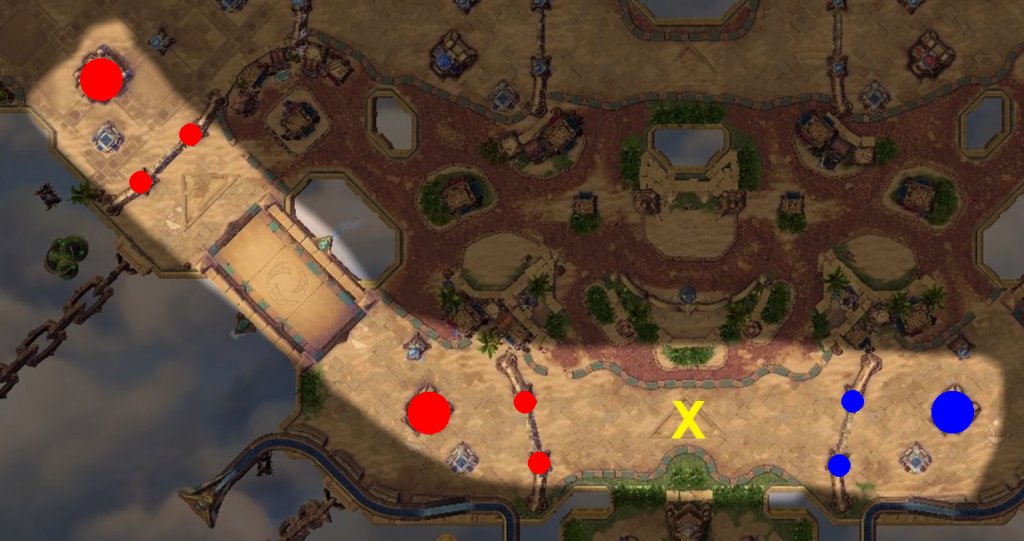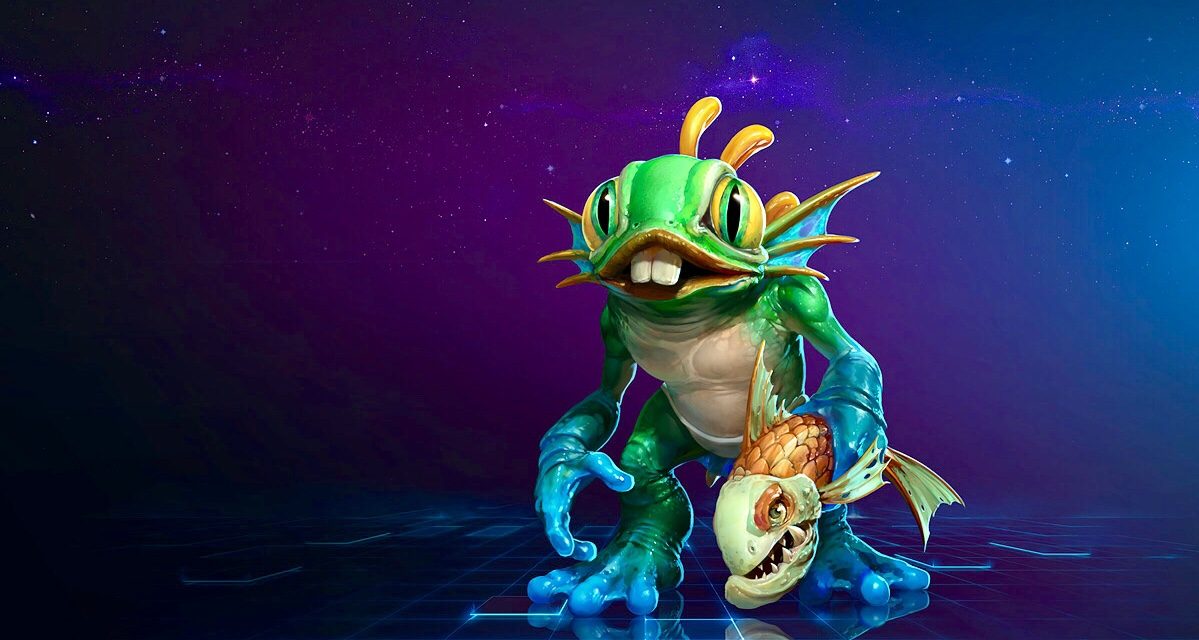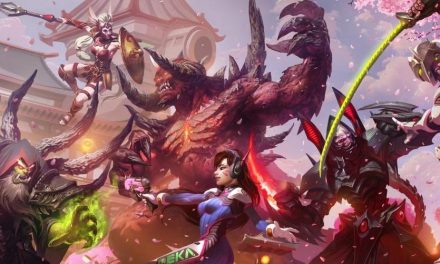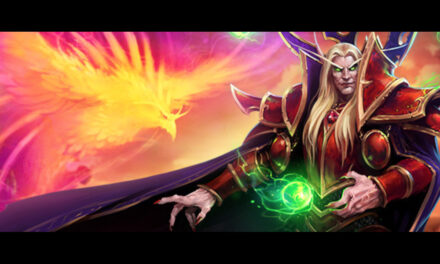Alright, fellow fans of the fishiest character in all of Heroes of the Storm. In previous articles I’ve discussed how to get the most use out of this often-underrated specialist, and today I want to lean into the mechanics that can make Murky a real force to be reckoned with when it comes to dominating the battlefield. Almost none of the strategies I present here will make you a shining star on the scoreboard, but if done properly, it will give your team a very good chance at winning and having a good game both—those two ideas not always being the same thing.
Lane Populations
In the traditional 3-lane HOTS map, often Murky is left to address a single lane all himself. While it takes a good while before he can present any serious threat to other heroes, The bipedal fish does have a great capacity to chip at enemy defensive structures, bit by bit eroding them until at last they come crashing down. Because Murky isn’t a significant threat on the battlefield, or is at least easily overlooked, often he is left alone by the other team, preferring to have more heroes push against stronger enemies elsewhere in the map.
While some characters have the ability to empower the NPC minions and mercenaries which make their way through the lanes, such as Raynor with his Inspire or Zagara with Infest, Murky doesn’t have any direct ability to increase the effectiveness of these creatures, but with careful planning he can still maximize their benefit and have them do most of the heavy lifting when squaring off against enemy structures.
Every thirty seconds, a wave of minions makes their way out of each team’s core structure and they continue through their assigned lane until they reach resistance. Unaided or unhindered, this means that both teams will have minions crash against each other at exactly the midpoint between the team’s defensive structures. Barring some randomness with how much damage they deal to one another, these waves should in theory be evenly matched. When a hero helps tip the balance in favor of their own minions, the NPCs march up to the fortified gates and towers of their opponent, doing permanent damage to those structures before they are blown away by defensive structures.
Increasing Pressure
Here is a (very) rough sketch of part of the bottom lane from the map Sky Temple. I have highlighted the lane itself, marked the red team’s defensive structures, and identified where the minion waves will traditionally engage with one another. I will be referring back to this diagram many times through the rest of the post.

Without interference, the red and blue minion waves will meet each other at the “X” and largely annihilate one another, with any stragglers killed by the small defensive turrets positioned on each wall. I’m repeating myself here because these concepts are very important—any minions which aren’t killed in the central melee, such as by being bolstered by a friendly hero, will make their way to the other team’s walls and start hitting them, causing permanent damage. If a team can consistently kill the enemy minion waves just as they reach the midfield, before they engage with their own units, there’s a very good chance that each wave will be able to chip at the defensive structures before expiring.
Characters like Tassadar and Azmodan have great area-of-effect abilities that can be used to cripple or destroy enemy minion waves, and Murky joins that list with the combination of Slime and Pufferfish skills. At level one, sliming the entire wave, then laying down a puffer fish trap, and then sliming them again just before the trap explodes can kill the lot of them with three button presses, and these abilities get even stronger as the match progresses. With the shortest respawn time in the game, Murky can take risks and overextend without great loss to the team as a whole.
Nothing I’ve yet said may sound revolutionary or novel in the way a solo-lane character like Murky conducts himself, but I’ve already presented each of the key components of this most effective strategy.
What if Murky, instead of engaging with friendly minions at the X, instead made his way around the defensive structures and attacked enemy waves on that narrow bridge between the red team’s keep and fort? Let’s map out a sample timeline.
- Red wave 1 and Blue wave 1 meet at the X, with neither side winning.
- Murky makes its way to the bridge and intercepts Red wave 2, killing it
- Blue wave 2 meets no resistance and applies its full force against the Red team’s outer walls
- Murky repeats the process with Red wave 3
- Blue wave 3 again meets no resistance and assaults the structures
- Repeat until either (1) the red team sends someone down to stop Murky, which pulls them away from whatever team fight they were engaged in previously, or (2) the structures get destroyed through sheer NPC pressure
What’s more, Murky is collecting 100% of the XP dropped by the red minion waves while the enemy team which is leaving him alone loses out on that which is generated by the blue minions, disappearing several seconds after the minion’s death.
Understanding the Value
Murky, a character which few players lend any attention to, is able to penetrate enemy lines at little risk to himself—a death means he merely comes back eight seconds later with no penalty. By engaging the enemy minion waves out of range of the key defensive structures, he is able to wipe them out with neigh-impunity, allowing his own minion team to advance. Rather than the blue minions spending their time attacking red minions, they spend their lives doing real, permanent damage against red’s structures, eventually weakening them to the point of breaking.
In this way Murky is almost doubling his lane’s effectiveness, earning XP while having friendly minions focus on their important task. If nobody comes down to attack the blue wave or the murlock itself, the defending team will quickly find themselves outlevelled and out-structured as their own buildings come crashing down.
What’s more, I have seen enemy players get so incensed at the idea of a hero wrecking havoc in “their” space that they send not just one but two or three heroes to stop the threat of Murky. Murky, who is worth one-quarter of the XP to kill of a regular hero, and who has limited team fight viability until later levels. By committing such a force, the defending team all but guarantees they will lose whatever objective or teamfight they’d otherwise be engaged at.
Counters
Murky is of course not an unstoppable monster who can single-handedly defeat scores of enemies and leave nothing but burning carnage in his wake. He’s a fish. Like, a literal bipedal fish, out of water. He folds at the slightest resistance, and the number of characters he can effectively lane against is punishingly small.
The only thing an enemy team has to do to stop this advanced siege tactic is to send a hero down to the bottom lane. Not even to engage Murky—though that’s often a wise decision—but solely to kill the advancing minion wave. With both teams destroying minions before they reach the opposing defensive structures, the lane effectively becomes a stalemate with neither side gaining or losing ground.
“This is so silly,” you may be thinking to yourself, “why wouldn’t the team have someone in lane against Murky?” You are very right to think these thoughts, but my own experience has born out time and time again that many teams would rather have a slight advantage at map-center teamfights than stop what they see as a middling threat in the far off corners of the battlefield.
Only after they realize that their front walls and towers are down, and that their fort is starting to take real damage, do they take Murky seriously, and then often overextend and send multiple heroes down to ruin his day for the audacity of diving behind enemy lines. That kind of overcommitment means Murky’s team now has the numbers advantage, as well as having put a significant dent in the lane’s defensive structures. Win win!
All images copyright Blizzard. Edits made for educational purposes.















